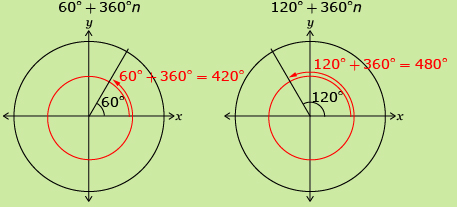In Try This 3 you explored what is called the general solution to an equation. A general solution is an expression that represents all solutions when the domain is unrestricted. A common way to write the general solution to the equation 2 cos θ + 1 = 0 is as follows:
θ = 120° + 360°n, n ∈ I and θ = 240° + 360°n, n ∈ I
Together, these represent all the solutions to 2 cos θ + 1 = 0.
The general solution to tan θ − 1 = 0 can be written as ![]() + nπ, n ∈ I.
+ nπ, n ∈ I.
| Equation | The General Solution | Angles the General Solution Refers To |
| 2 cos θ + 1 = 0 | θ = 120° + 360°n, n ∈ I | …−600°, −240°, 120°, 480°, 840°, 1200°… |
| θ = 240° + 360°n, n ∈ I | …−480°, −120°, 240°, 600°, 960°, 1320°… | |
| tan θ − 1 = 0 |
Watch and listen to How to Read a Solution.
The number of solutions contained in one rotation of the unit circle is often the number of expressions required in the general solution. An exception to this guideline occurs when solutions are one-half of a rotation apart, as shown in the previous tangent equation.

The solution to 2 cos θ + 1 = 0 requires two expressions. There is one expression for each unique point on the unit circle.

The solution to tan θ − 1 = 0 can be written as ![]() and
and ![]() These two solutions are one-half of a rotation, or π, apart so they can be combined to
These two solutions are one-half of a rotation, or π, apart so they can be combined to ![]() In degrees, this is 45° + 180°n, n ∈ I.
In degrees, this is 45° + 180°n, n ∈ I.
